REVIEWING THE BASIC COMBAT SEQUENCES

Eugene and Alex reviewing the four basic combat sequences in our sparring methodology
Two important ingredients for combat efficiency are techniques and skills. You need the best forms for the combat situations, and the best ways to put them into action.
Our Combat Sequences 1 to 4 focus on basic combat skills, whereas Combat Sequences 5 to 16 provide the basic techniques to meet all categories of attacks.
The four basic combat sequences also illustrate some effective tactics, and by combining the sequences in various ways they lay the foundation for devising various strategies for combat
Linking Many Sequences into One Continuous Sequence

Eugene and Alex go over Combat Sequences 1 to 4. Eugene initiates and links all the four combat sequences into one long continuous sequence. Eugene has to make a leg-mode adjustment when linking Sequences 3 and 4, because Sequence 3 ends with the right leg in front and Sequence 4 starts with the left leg in front. In this video clip, however, Eugene progresses only to Sequence 3 because Grandmaster Wong intercepts to explain some important points.
Essential to Cover yourself when Attacking

Grandmaster emphasizes that one must cover the opponent while moving in to attack after making the leg mode adjustment. If you merely moves in, you will expose yourself for easy counter-strikes. Grandmaster Wong reminds the participants that they have all learnt these, but he reviews the important safety points so that they will take care of these important points automatically.
The Principle of Safety First

Grandmaster Wong closes the opponent in such a way that it is difficult for the opponent to counter-strike when Grandmaster Wong attacks. Notice that Grandmaster Wong uses his left hand to “tame” the opponent's both hands, while he strikes with his right hand. He may also strike with his left hand as it is already close to the opponent, but he chooses to use it for coverage instead of for striking, even though it may be more likely to hit the opponent with the left hand than with the right hand. This follows the principle of “safety first”, i.e. you ensure yourself to be safe first before attempting to strike the opponent.
Add a Modification if Needed

Grandmaster Wong reminds the participants that they must cover not just the opponent's hands but also his legs so that he may not counter with a surprised kick. Instead of closing his hands, you can open them. Be aware that he may counter-strike with his left hand. If he does so, brush it away and continue to attack him as planned. Hence, a modification is added here if needed.
Right Spacing for Best Advantages
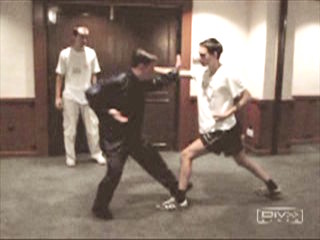
In his defence against Grandmaster Wong's attack, Alex moves his front left leg from a left Bow-Arrow Stance a full step backward to a right False-Leg Stance. Grandmaster Wong says that this big movement is unnecessary. It is sufficient to move the front left leg a small step backward to a left False-Leg Stance. Do you know the advantages of this small leg movement over the bigger leg movement?
Better Spacing for both Defence and Counter-Attack
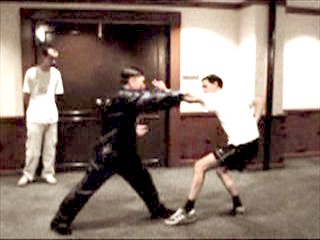
It is not only sufficient to move the front left leg a short space back into a left False-Leg Stance for defence, it also provides a better poise against possible follow-up attack. As shown in the video, if Grandmaster Wong moves forward to continue his attack, he would move into the dragon-hand of Alex. Moreover, it is easier now for Alex to counter attack.
Two Disadvantages of Moving too Far Back
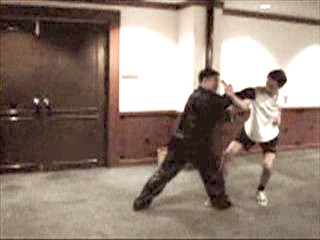
Moving back a big step from your left Bow-Arrow Stance to a right False-Leg Stance may give you more space between you and your opponent, and thus may be safer. But it also makes it harder for you to counter attack. Moreover, if your opponent is skillful, like Grandmaster Wong as shown in the video clip, he can exploit this and it may actually turn out to be more disadvantageous to you.
Three Different Attacks in One Sequence
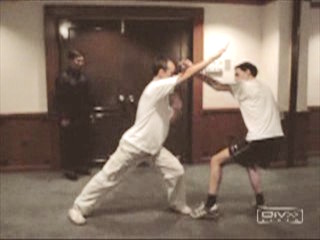
Eugene now completes Combat Sequence 4, which involves a top attack, a bottom attack and a side attack. The sequence should be performed smoothly as if all the patterns in the sequence were one long continuous pattern.
Having Fun with Subtraction and Addition
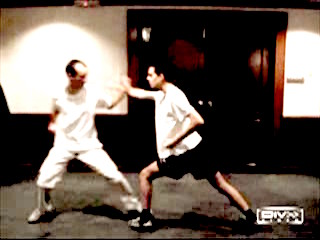
Now Alex links all the four sequences together into one long continuous sequence. You can then have some fun using this Sequence 1-2-3-4 series as the base for the “Subtraction and Addition” approach in our sparring methodology. First, you take out any one sequence from this series. You may, for example, use Sequence 1-2-4. Then you can take out another sequence, e.g. Sequence 2-4. Next, you may add any one sequence, like Sequence 1-4-3.
Reviewing Basic Combat Sequences from Wong Kiew Kit on Vimeo.
LINKS
How to Think and Act as a Master
- Returning to the Basics
- Form, Force, Flow and Element of Threat
- Reviewing the Basic Combat Sequences
- Devising Strategies Using Combat Sequences
- Applying Strategies for Effective Combat
- Free Sparring with Prescribed Conditions
- Combat Sequences to Train Spontaneous Attacks and Responses
- Using Strategies and Tactics in Attack and Defence
- It is Heartening to see so Many People Using Kungfu in Free Sparring
- Felling and Gripping Techniques in Shaolin Kungfu
- How Sequence Training and Chi Flow Enhance Combat Efficiency
- The Tiger-Crane Set — Manifesting the Hard and the Soft in Shaolin Kungfu
- The Dragon-Tiger Set — Crystallization of Two Wahnam Traditions
- The Dragon-Form Set — Demonstrating that Softness Can be Very Powerful
- Shaolin Monkey Set — Symbolizing Spiritual Path from Cheekiness to Enlightenment
- Shaolin Five-Animal Set — Gist of Shaolin Forms and Essence
- Shaolin Pakua Set Set — An Exclusive Set Fit for Kings and Generals
- Combat Application pf Pakua — Sharing Secrets for Combat Efficiency
- Beginning to Learn some Monkey Tricks
- Refining Techniques in Combat
- Some Examples of High level Combat
- Collective Effort for Greater Benefits
- Can Sophisticated Kungfu Techniques be Used in Combat?
- Skills are usually More Important than Techniques
- One-Finger Shooting Zen — the Treasure of Shaolin Wahnam
- Raising Levels of Techniques and Tactics in Combat
- Bringing Combat Skills to More Sophisticated Levels
- Monkey Techniques are Flowing and Agile but can be Very Devastating
- Flowing with the Opponent's Momentum
- Beware of the Monkey Tricks
- Marvelous Techniques Beget Marvelous Techniques
- How to Raise your Level of Combat
- How you can Defeat your Opponents
- Employing Sophisticated Kungfu Techniques to Enhance Combat Efficiency
- Systematic Training is Essential for Combat Efficiency
- Raising Combat Efficiency from Basic to Advanced Levels
- Kungfu Philosophy and Swaying Willows
- Hands Pave the Way, Kicks to Clinch Victory
- Six Harmonies of the Double Tiger Claws
- The Amazement and Effectiveness of Monkey Kicks
- A Bag Full of Monkey Tricks
- Gentle and Flowing, yet Very Powerful
- Can your Responses still be Correct and Spontaneous in Real Fights?
- Incorporating Kicks into Combat Sequences
- Elaborate Patterns to Meet Complex Combat Situations
- The Benefits of Understanding and Applying Kungfu Philosophy
- Our Kungfu is a Training of Energy and Mind
- Ensuring Own Safety when Felling Opponents
- The Beauty and Profundity of Shaolin Felling Techniques
- Felling Techniques of the Dragon and the Monkey
- Felling an Opponent Without him Realizing What has Happened
- Pattern Analysis of the Tiger-Crane Set
- Tiger Patterns for Chin-Na, Against Kicks and Countering the Shoot
- Pattern Analysis of the Dragon-Tiger Set
- Revealing the Secret Tactic of Leak Hand
- From the Level of Techniques to the Levels of Tactics and Strategies
- Pattern Analysis of the Dragon-Form Set
- Effective Techniques for Fighting on the Ground
- Pattern Analysis of the Monkey Set
- Soft Techniques and Internal Force in Monkey Kungfu
- Interesting Monkey Patterns that are Deadly for Combat
- Pattern Analysis of the Pakua Set
- Pattern Analysis of the Five-Animal Set
- Variety of Techniques in Shaolin Five Animals
- Investigating the Combat Applications of Some Patterns
- Similar Patterns but Different Applications
- Effective Counters against Kicks, Grips and Knee Jabs
- Secrets of Skyward Cannon Punch in Continuous Attack
- Cannon Punch Towards Sky and Fierce Tiger Crouching on Ground
- Flowing Monkey Techniques against Powerful Tiger Claws
- Sophisticated Grips and Sophisticated Counters
- Breaking an Opponent's Elbow and Wrist
- Neutralizing Wrist Lock and the Three Harmonies
- Advanced Chin-Na Techniques and Counters
- Two Stories about Kicks
- How to Respond to Attacks Spontaneously and Correctly
- Can Beautiful Patterns and Flowing Movements be Effective in Combat?
- Linking Combat Sequences into a Set
- From Pre-Arranged Sparring to Combat Efficiency
- Crystalization of Combat Techniques from Past Masters
- Hei Sai or the Spirit of Energy
- Manifesting the Energy and Spirit of your Form
- Manifesting the Spirit of the Form
- Kungfu Practice is not just Physical Training but also Spiritual Cultivation
- Fluidity of Form, Energy and Spirit
- Shaolin Kungfu is Chi Kung and Meditation
- Revealing the Secrets of Shaolin Masters
- The Profundity of Shaolin Combat Application
- It is Easy to Fight against Boxers
- Avoiding a Boxer's Strong Points and Attacking his Weaknesses
- Some Effective Tactics against Boxers
- The Strategy of Not Allowing an Opponent to Escape
- The Strategy of Letting Trick Manifesting Trick
- The Strategies of Interception and of Striking Form
- Standardized Routines of Kick-Boxing Attacks
- Some Effective Counters to Kick-Boxing Attacks
- Felling a Kick-Boxer when he Kicks
- The Secrets of Two Tigers Subdue Dragon
- Shaolin Counters against Kick-Boxing and Karate
- Some Important Combat Philosophy and Principles
- It is Relatively Easy to Handle Karate Attacks
- Good Spacing When Executing Kicks
- A Variety of Taekwondo Kicks
- Effective Shaolin Counters against Taekwondo Kicks
- Trapping Legs and Subduing Opponents
- Making Expedient Changes to Surprised Attacks
- The Legacy of Sigung Ho Fatt Nam — Planting Willow in Front of Camp
- Having Fun in Throws and their Counters
- Sharing the Secret of Move Stance Change Step
- Some Unorthodox Felling Techniques Not Commonly Seen
- Felling Opponents with your Stances!
- Beware of Monkeys; they are Expert at Plucking Peaches
- Sophisticated Footwork and Leg Techniques of Monkeys and Gorillas
- Wrestling Throws are Found in Shaolin Kungfu Too
- Real Fighting is Different from Martial Sports
- Who Says there is no Ground-Fighting in Shaolin Kungfu
- An Incredible Secret of One-Finger Zen
- Understanding Muay Thai Fighting Strategies and Techniques
- Various Strategies to Counter Muay Thai Fighters
- Responding to Muay Thai Attacks Spontaneously and Correctly
- Avoiding Opponent's Strength and Attacking his Weakness
- Effective Ways to Counter Sweeping Kicks
- Effective Counters against Knee and Elbow Strikes
- Crouching Tiger against Grab Neck Elbow Strike
- Shaolin Kungfu for Combat Efficiency, Good Health and Spiritual Development
